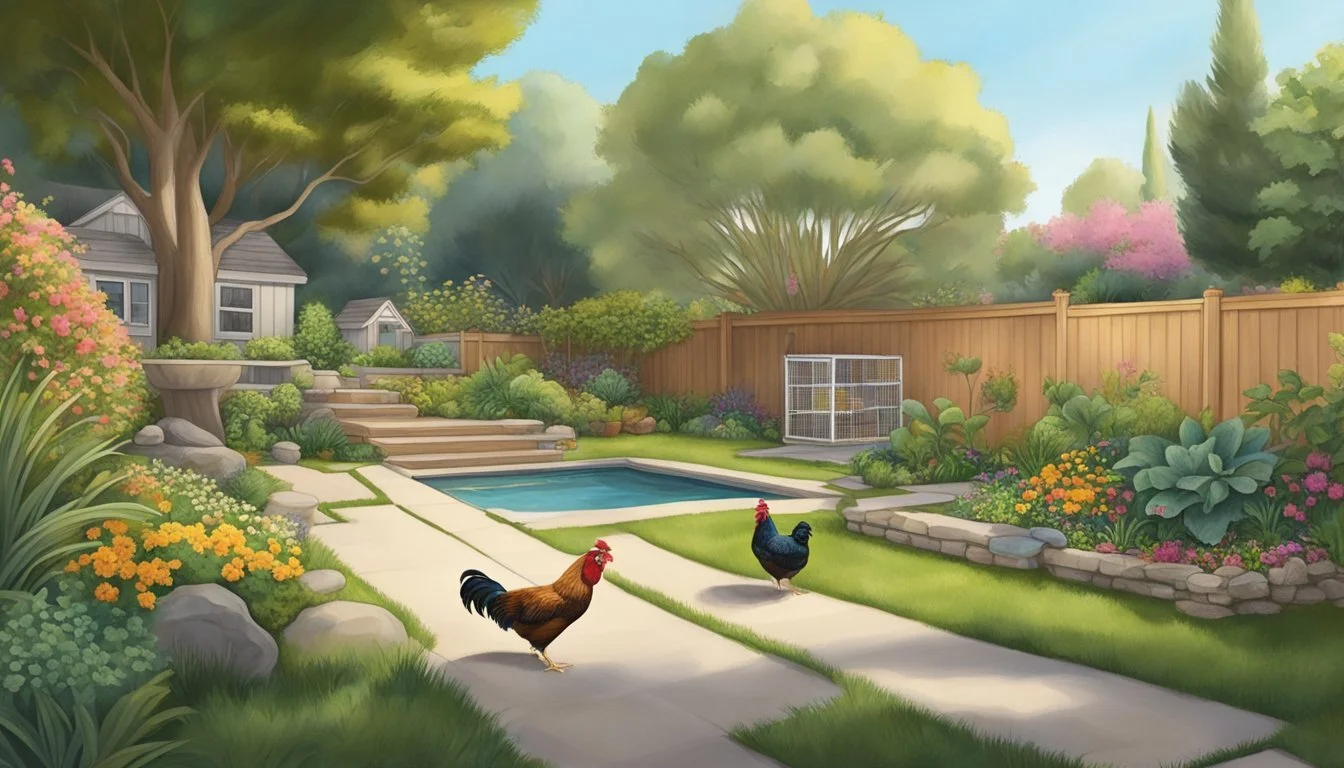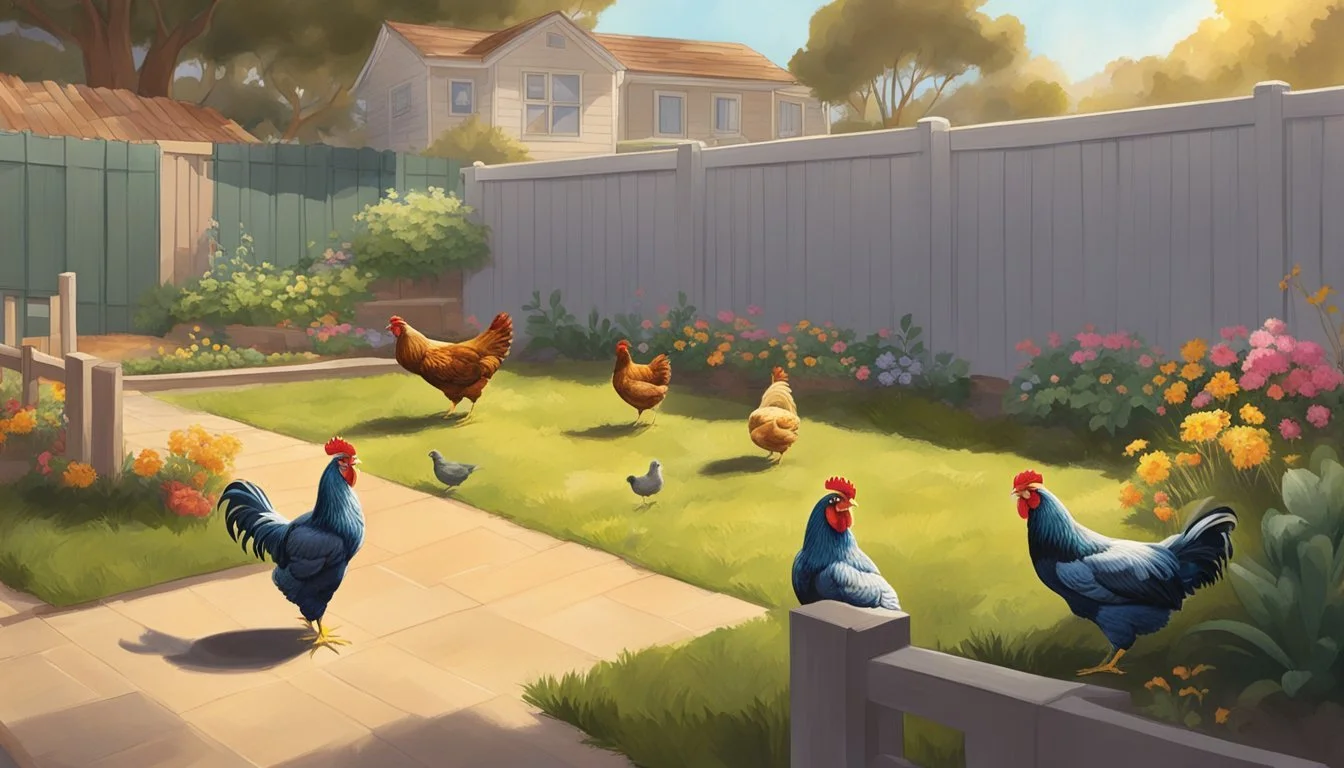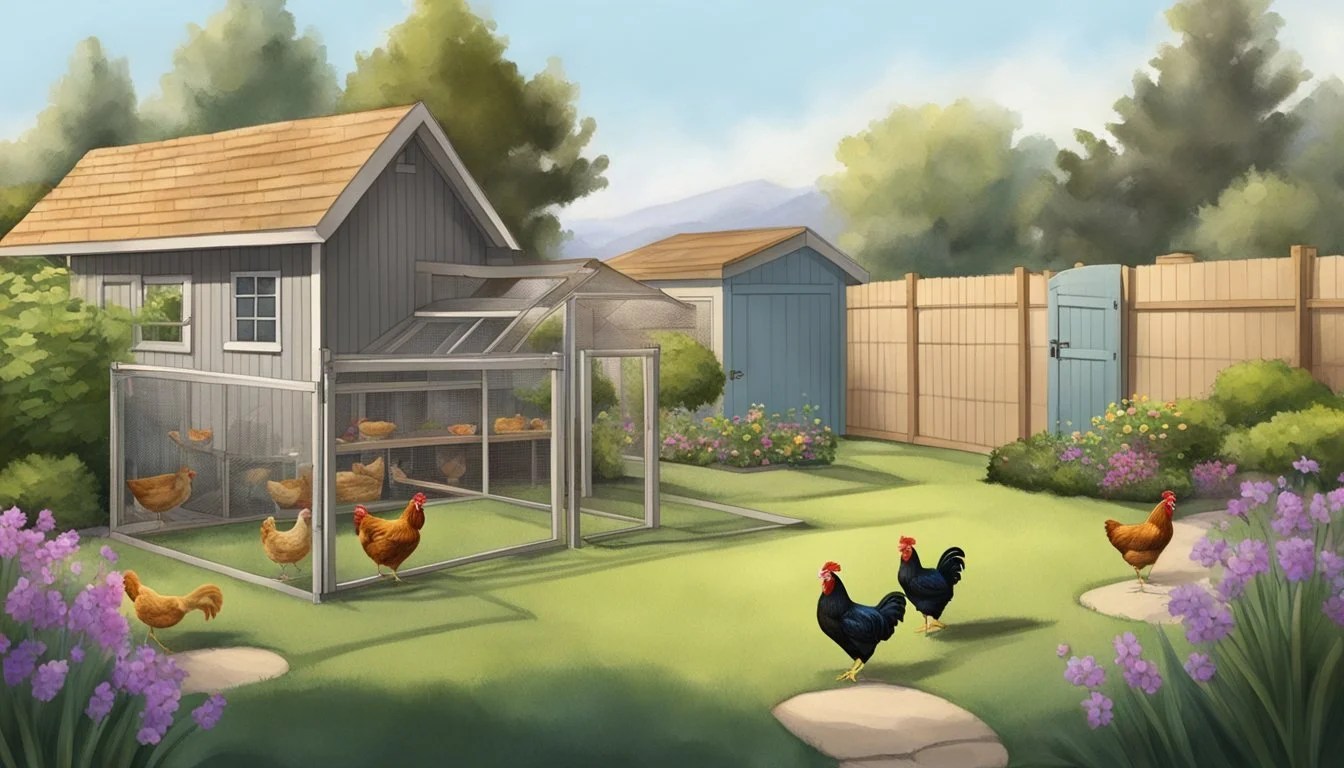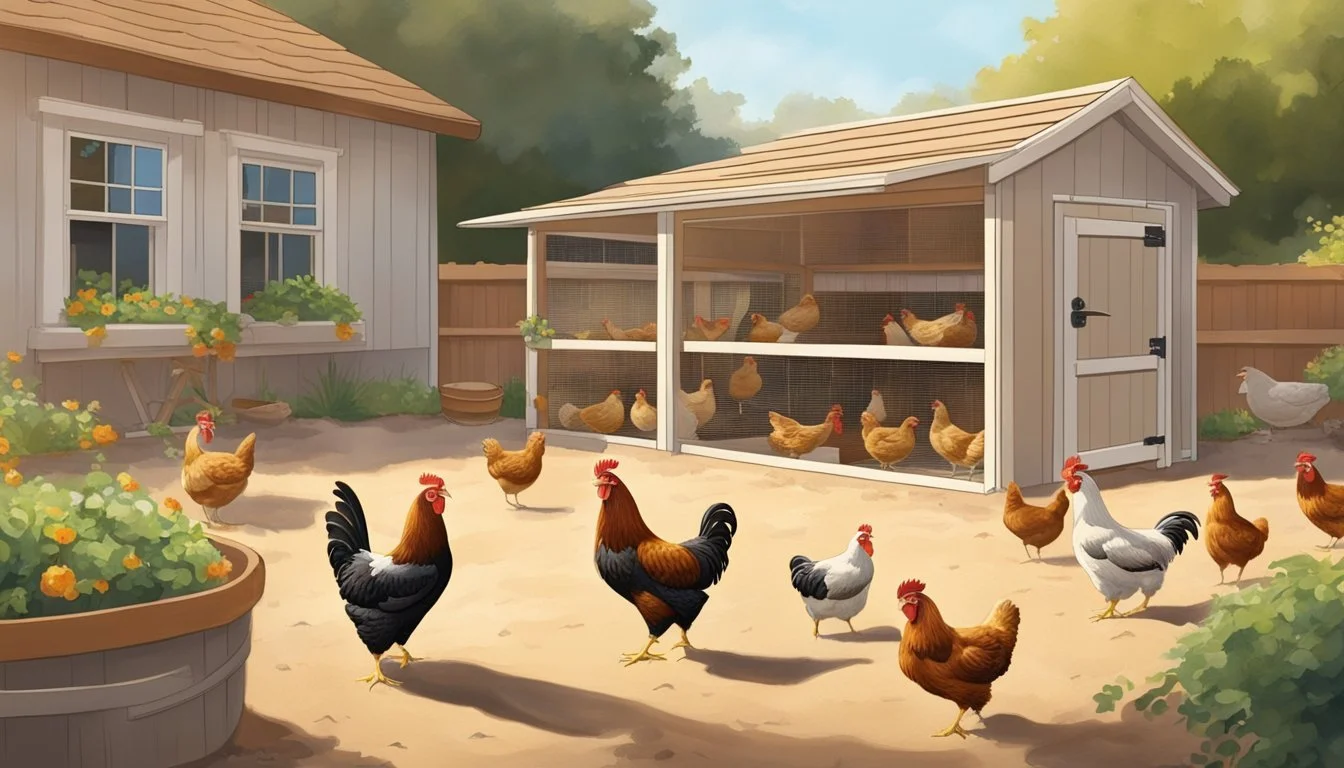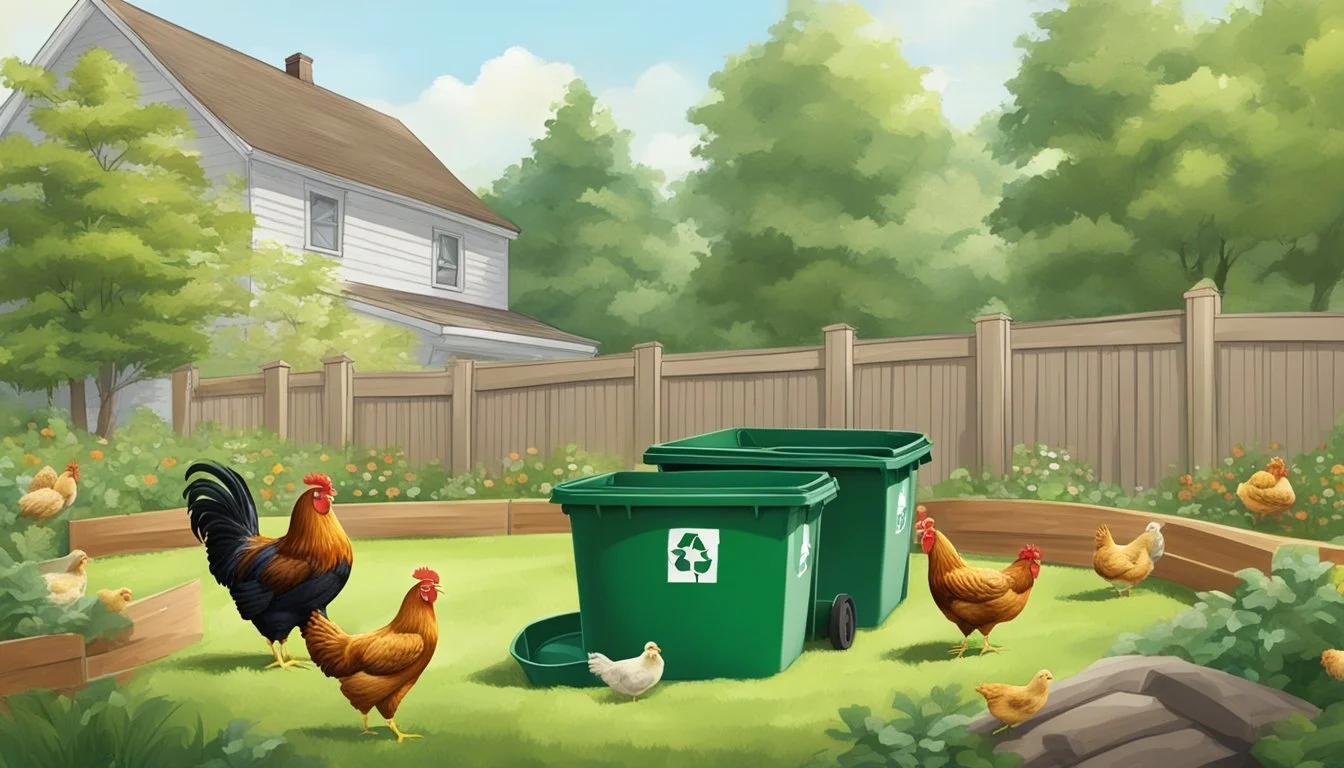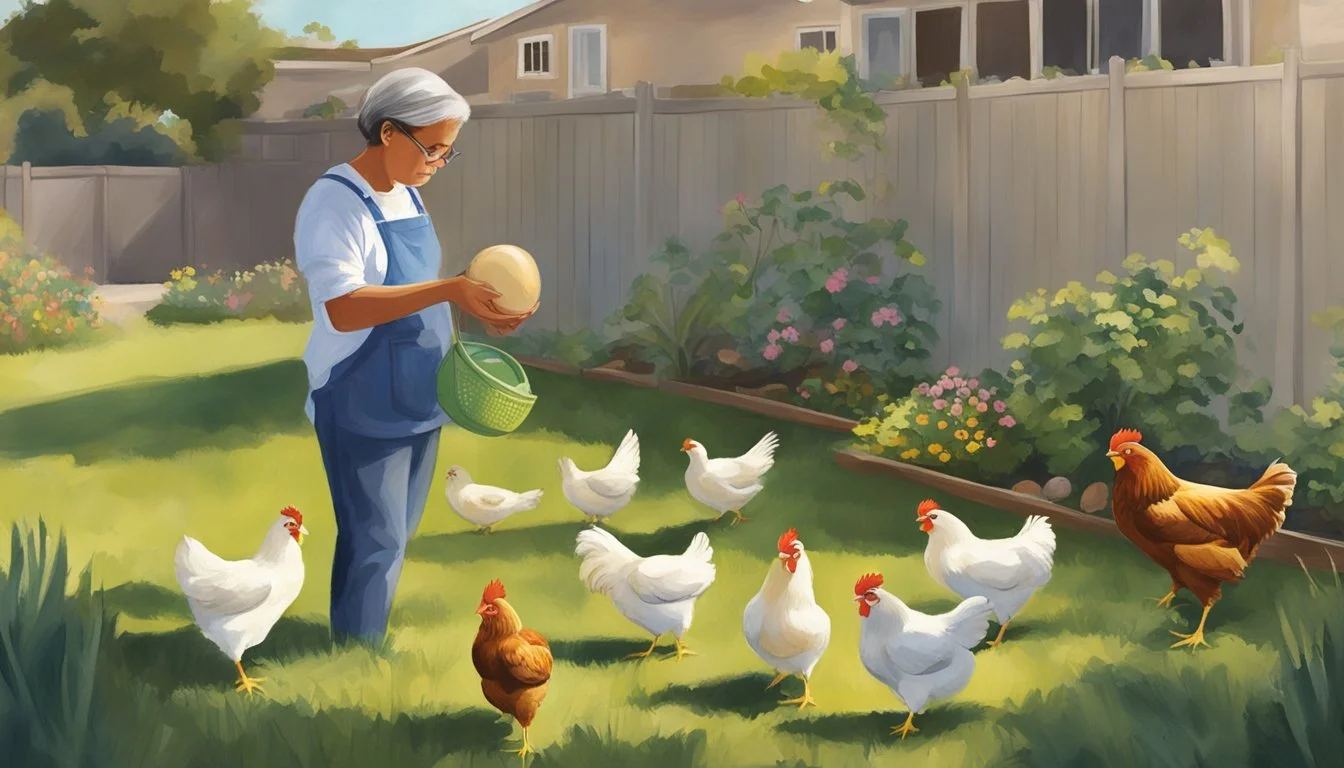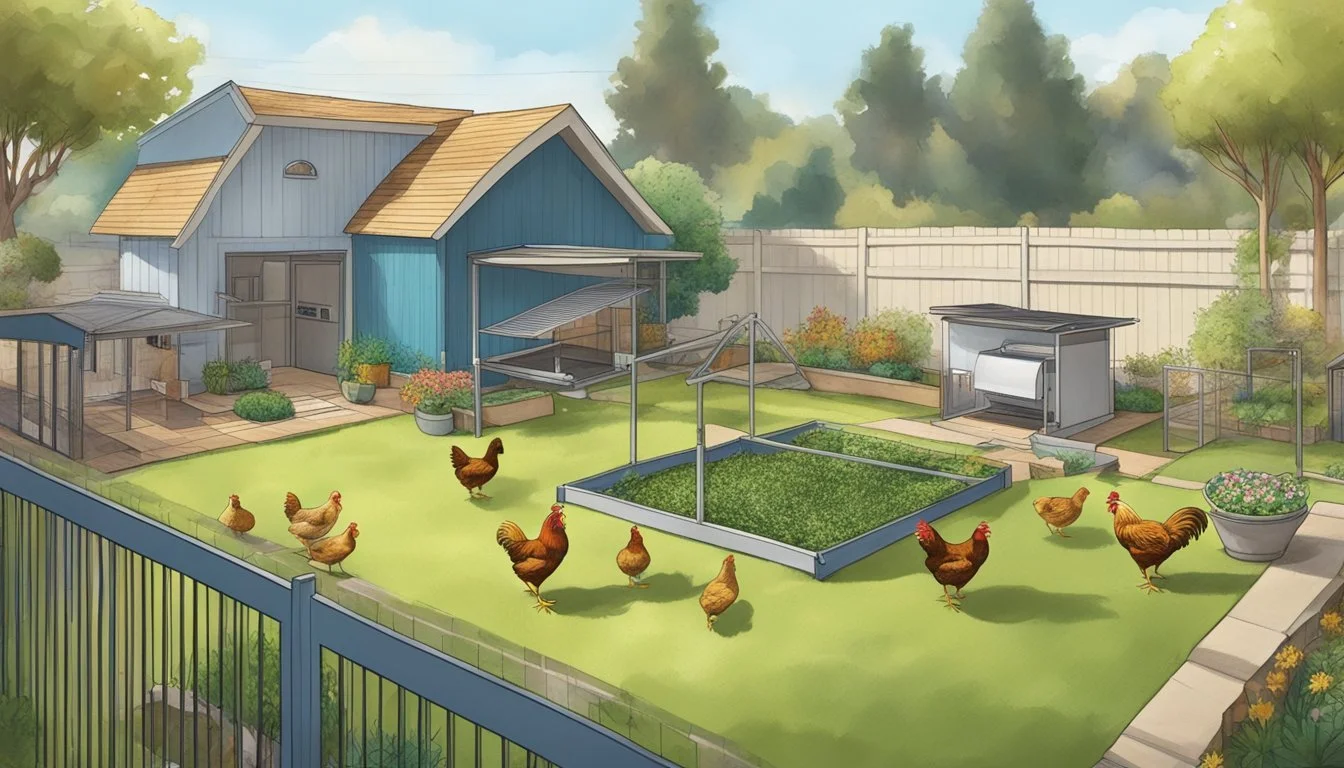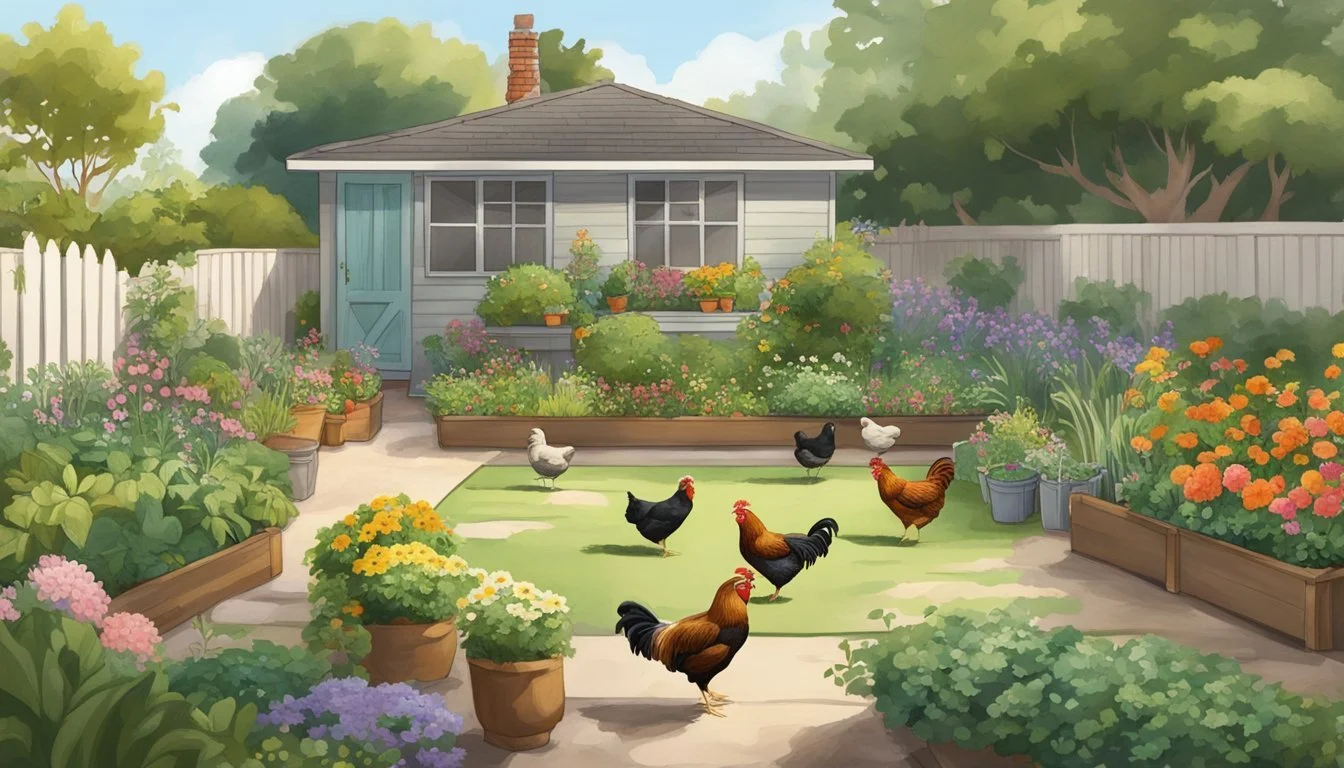Keeping Backyard Chickens in Torrance, CA
Essential Guidelines and Regulations
Many residents in Torrance, California are embracing the trend of raising backyard chickens as a source for fresh eggs, natural pest control, and the enjoyment of having these birds as pets. The city has specific ordinances governing the keeping of chickens within its boundaries to ensure the well-being of the animals, as well as to address any concerns of neighbors and maintain community standards.
The number of chickens allowed on a property in Torrance depends on the size of the lot. For properties under 10,000 square feet, residents can keep up to four chickens, while those with larger lots are allowed up to six chickens. It's important to note that these regulations are designed to accommodate different residential zones and to balance urban living with the desire for a more sustainable lifestyle. There are additional guidelines regarding coop placement and the prohibition of roosters to minimize noise and maintain neighborhood harmony.
Before embarking on the establishment of a backyard flock, potential chicken keepers in Torrance should familiarize themselves with the local ordinances. Compliance with city regulations is crucial not only to avoid penalties but also to ensure that neighborhood relationships remain positive and that the chickens receive proper care and housing.
Understanding Local Regulations
Keeping backyard chickens in Torrance, California, requires adherence to specific municipal codes and zoning laws. Prospective chicken owners must navigate permits and licensing requirements to comply with local regulations.
Torrance Municipal Code and Zoning
The City of Torrance enforces municipal codes that dictate where and how residents can keep chickens. Zoning laws particularly focus on property types and locations where chicken keeping is permissible. Key zoning considerations include:
Property Setbacks: Specific distances from property lines and structures are mandatory.
Land Use: The type of land use may impact the ability to keep chickens, as residential, commercial, and agricultural zones may have different regulations.
Permits and Licensing Requirements
To legally keep chickens in Torrance, obtaining a Special Animal Permit is a critical step. This permit outlines requirements and conditions for chicken keeping, which include:
Fee: A fee of $122 is generally required.
Site Plan: Submission of a detailed site map indicating the proposed location of coop and run on the property.
Structural Details: Provision of drawings and dimensions for the chicken coop and run is necessary for permit consideration.
Ongoing Compliance: Permit holders must maintain their coops and chicken keeping practices in line with stipulations set by the City.
Prospective chicken keepers in Torrance should contact local authorities and review the Torrance Municipal Code in full to ensure they meet all local regulations for backyard chickens.
Choosing the Right Chickens
When selecting chickens for a backyard coop in Torrance, CA, it’s essential to consider breed characteristics, the distinction between hens and roosters, and local regulations pertaining to the number of chickens allowed.
Selecting Breeds
Choosing the right breed of chicken depends on what they are being raised for. Egg-laying breeds such as Rhode Island Reds and Leghorns are favored for their productivity. Those interested in meat may opt for broiler breeds like the Cornish Cross. For a balance of egg-laying capability and meat production, dual-purpose breeds such as Plymouth Rocks and Orpingtons are suitable. One must also take into account the climate adaptability of the breed, as well as their temperament, especially in a residential setting.
Egg-Laying Breeds: Leghorns, Rhode Island Reds
Meat Breeds: Cornish Cross
Dual-Purpose Breeds: Plymouth Rock, Orpington
Climate & Temperament: Need to be suitable for CA climates and residential areas
Hens vs. Roosters
Hens are the females of the chicken species and are typically kept for egg production. They do not require a rooster to lay eggs. Roosters, the male chickens, are often more aggressive and are prohibited in Torrance. Therefore, residents should ensure their flock is composed solely of hens or unsexed chicks (pullets) which are young hens that have not yet begun to lay eggs.
Hens: Kept for eggs, no need for roosters
Roosters: Prohibited in Torrance, CA
Pullets: Unsexed young hens not yet laying eggs
Number of Chickens Allowed
Per Torrance, CA ordinances, properties sized less than 10,000 square feet can keep up to four hens, while those with more extensive properties may be permitted to keep more. Residents are advised to verify current regulations with city authorities as ordinances can change.
Properties < 10,000 sq.ft.: Up to four hens allowed
Properties > 10,000 sq.ft.: Possibility for more hens; check local regulations
Setting Up Your Coop
When setting up a chicken coop in Torrance, CA, attention to detail is crucial for the birds’ safety and comfort. Local regulations should be observed, such as the proper coop placement and space requirements. Essential considerations include coop size, predator protection, and nesting box design.
Coop Size and Dimensions
The size and dimensions of a chicken coop should provide adequate space for the chickens to move comfortably and engage in natural behaviors. A standard recommendation is to allocate at least four square feet of space per chicken inside the coop. This ensures that each bird has enough room to live healthily.
Minimum Size Guide:
For 4 chickens: 16 square feet
For 6 chickens: 24 square feet
The coop must also adhere to local Torrance requirements, with distances of 15 feet from the back of the property line and 10 feet from the side of the property line.
Protection from Predators
A predator-proof chicken coop is non-negotiable to keep the birds safe from harm. All entry points, including doors and windows, should be secured with sturdy latches. Additionally, hardware cloth instead of chicken wire can offer better protection against predators such as raccoons, foxes, and hawks.
Key Features:
Locks: Raccoon-proof twist latches.
Wiring: Hardware cloth with less than 1/2" openings.
Foundations: Buried perimeter to prevent digging predators.
During the winter months or nocturnal hours, when predators are most active, vigilance in ensuring that coops are sealed and secure is of heightened importance.
Creating Comfortable Nesting Boxes
Nesting boxes should be a cozy and inviting space for hens to lay their eggs. Each box should measure around 12x12x12 inches to allow enough room without wasting space. A general rule is one nesting box for every three hens. They should be filled with straw or shavings and be easily accessible for both the chickens and the owners for egg collection.
Nesting Box Specifications:
Size: Approximately 12"x12"x12".
Ratio: 1 box per 3 hens.
Material: Soft, clean bedding such as straw or wood shavings.
These comfortable nesting boxes ensure that hens have a designated place to lay their eggs, which can help in maintaining a clean and orderly coop environment.
Chicken Care Basics
Ensuring the health and well-being of backyard chickens in Torrance, CA, involves proper feeding, consistent access to water, maintaining cleanliness, and disease prevention. Adhering to these fundamentals is critical for raising healthy poultry.
Feeding Your Chickens
Chickens require a balanced diet that includes grains, proteins, and minerals to thrive. Starter feeds are important for chicks, while adults benefit from a layer feed. Feeding schedules and portions vary by age:
Chicks (0-6 weeks): Starter feed, 20-22% protein.
Pullets (6-20 weeks): Grower feed, 14-16% protein.
Laying hens: Layer feed, at least 16% protein.
A feeder can ensure feed remains clean and dry. Additionally, chickens enjoy kitchen scraps and compost as a treat, which can aid in reducing waste through composting.
Water and Hydration
Chickens need constant access to fresh water. Water dishes or automated watering systems should be cleaned regularly to prevent the spread of disease. Each chicken typically drinks about one pint of water daily, but this can increase in warmer weather.
Cleanliness: Change water daily.
Hydration: Monitor more during heat.
Maintaining Cleanliness
A clean coop reduces the risk of disease and pests. Use absorbent materials such as sand or straw in the coop to make cleaning easier and encourage composting of manure:
Daily: Spot-clean waste and refresh water.
Weekly: Scrub feeders and waterers.
Monthly: Replace bedding and perform a deep clean.
Proper disposal of waste and spent bedding is crucial to maintaining a healthy environment for chickens.
Health and Disease Prevention
Regular health checks are essential for preventing and quickly addressing diseases. Common signs of illness include lethargy, abnormal droppings, and refusal to eat. Isolating sick birds is crucial to prevent the spread of disease. Vaccinations and parasite control should be part of a routine health plan:
Vaccinations: Consult with a local vet for recommended vaccines.
Parasite Control: Routine checks for mites and lice.
Planning, buying quality supplies, and dedicating time daily to chicken care are the pillars of maintaining a healthy backyard flock.
Daily and Seasonal Routines
Maintaining a productive and healthy flock of backyard chickens in Torrance, CA involves adhering to a disciplined schedule for daily care and making necessary seasonal adjustments. Below are the vital components of these routines.
Regular Feeding Times
Chickens thrive on routine, so consistent feeding times are essential. Owners should provide a balanced diet of feed once or twice daily. Early morning is an ideal time for the first feeding to ensure chickens have the energy for the day, while a late afternoon feeding ensures they are satiated before roosting. Fresh water should be replenished daily to maintain hydration and health.
Morning: Feed and fresh water
Late Afternoon: Second feed
Egg Collection
Egg collection should occur at least once a day to ensure fresh eggs are retrieved and prevent any potential damage. Morning is often the best time for collection as many hens lay eggs early in the day. In the winter, when daylight hours are shorter, egg production may decrease.
Morning: Primary egg collection
Evening (optional): Check for any additional laid eggs
Seasonal Adjustments
Seasonal changes in Torrance, CA require adjustments in the care of backyard chickens, particularly during winter months when additional measures to protect from colder temperatures are needed.
Winter Basics:
Increase the frequency of bedding changes to maintain warmth.
Ensure water does not freeze and remains accessible.
Consider additional lighting to compensate for shorter daylight hours and support continued egg production.
Raising Chicks to Hens
Raising chicks to fully-fledged hens in Torrance, CA, involves dedicated care through stages like incubation, brooding, and growth milestones. Each step is crucial and requires careful monitoring to ensure the healthy development of chicks into hens.
Incubation and Hatching
When incubating eggs, maintain a consistent temperature of 99.5 degrees Fahrenheit and a humidity level of 55-60%, increasing to 65% in the final days of hatching. Turn the eggs several times a day to ensure even warmth. After 21 days, chicks should begin to hatch, signified by the first cracks or "pips" in the shells.
Brooder Setup
Post-hatching, set up a brooder area. This should be a warm, draft-free space that provides each chick with around 0.5 square feet of room to grow for the first few weeks. A radiant heater should maintain a temperature of 95 degrees Fahrenheit for the first week, decreasing by 5 degrees each subsequent week. The brooder should include a feeder, waterer, and bedding, which could be pine shavings or similar material.
First week: 95°F
Each following week: Decrease by 5°F
Provide private nesting boxes as they grow, to prep them for laying.
Growth Milestones
Monitor the chicks for important growth milestones. At 6 weeks, they typically begin to transition to outdoor coops. By 18 weeks, most chicks will have developed into pullets or young hens. Research the specific breed of your hens for precise growth rates and behavioral benchmarks.
6 weeks: Transition to coop
18 weeks: Pullet stage (young hen)
Throughout the process from hatching to laying, nutrition plays a vital role. Start chicks on a high-protein starter feed to promote strong development, later transitioning to layer feed as they approach laying age.
Dealing with Waste
Effective waste management is crucial for backyard chicken keepers in Torrance, CA, to maintain a sanitary environment and comply with local ordinances.
Composting Chicken Manure
Composting chicken manure offers a beneficial solution for waste concerns. This process transforms manure into valuable fertilizer over time, capitalizing on its high nitrogen content. To begin composting, one must establish a balance of green (nitrogen-rich) and brown (carbon-rich) materials, ensuring the compost pile heats properly and decomposes efficiently. The ideal ratio for composting is typically 1 part green to 2 parts brown.
The compost pile should be maintained regularly to facilitate proper decomposition. This involves routine turning of the compost pile to aerate the materials and speed up the composting process. Regular turning ensures evenly distributed decomposition and prevents unpleasant odors.
It is important to allow enough time for composting to take place. The composting process for chicken manure can take between 6 to 12 months before the material is safe and suitable for use as fertilizer. During this time, one should monitor the temperature and moisture levels of the compost to maintain optimal conditions.
Chicken keepers should note that while the composted material is an excellent fertilizer, raw chicken manure should never be applied directly to plants, as it can burn them and may contain pathogens. Through composting, chicken manure is converted into a safer, more usable form, closing the loop in backyard sustainability practices.
Safety Measures
Keeping backyard chickens in Torrance, CA requires specific safety measures to ensure the wellbeing of the poultry. Proper precautions prevent escapes and protect chickens from common urban threats, such as predators and theft.
Preventing Escapes
Chickens are naturally curious and may wander if their environment isn't secure. It's crucial to enclose their coop and run area with sturdy fencing material. The fence should be buried at least 12 inches underground to deter digging. Regular checks for gaps or weaknesses in the enclosure are necessary, since chickens can squeeze through surprisingly small spaces or may attempt to fly over if the fence isn't tall enough.
Checklist to prevent escapes:
Enclosure fences should be at least 6 feet tall
Fences buried 12 inches to prevent digging
Regular inspection for holes or weak spots
Clipping wings to hinder flying attempts
Deterring Theft and Predators
Chickens in urban areas like Torrance, CA are at risk of being stolen or attacked by urban predators such as raccoons, hawks, or even neighborhood pets. It's vital to build a predator-proof coop and run. The coop should have lockable doors and windows with sturdy latches. Installing motion-sensing lights can deter both human thieves and nocturnal predators.
Methods to deter theft and predators:
Coop with lockable doors and reinforced latches
Hardware cloth over windows and ventilations
Motion-sensing lights around the coop
Secure the coop each night without fail
By employing these safety measures, one can greatly reduce the risks associated with keeping chickens in a backyard setting.
Landscape Integration
Integrating chickens within a residential landscape requires thoughtful planning to ensure the backyard environment remains healthy and aesthetically pleasing. A balance between the needs of the chickens and the design of the garden is crucial for successful landscape integration.
Free-ranging in Your Garden
Free-ranging chickens can significantly benefit residential gardens by reducing pests and aiding in composting. However, it's important for Torrance residents to design their gardens to accommodate their chickens' ranging behavior. They should provide a chicken coop that's easily accessible, yet positioned to minimize disruption to garden aesthetics and functionality. To prevent damage, gardeners might use barriers around delicate plants or designate specific free-ranging areas to protect the overall landscape.
Ranging Areas: Define areas where chickens are allowed to roam.
Protection Measures: Use chicken wire to protect vulnerable plants.
Benefitting from Chickens as Pets
Chickens contribute to backyard farming experiences and can be a delightful addition as pets. They offer more than just eggs; their behaviors and interactions can be quite entertaining. To optimize the benefits of having chickens, Torrance residents should ensure their coops incorporate well into the garden design, perhaps using natural materials that complement the residential scenery. It's also valuable to consider the aesthetics of the coop and its visibility from various points in the yard.
Coop Design: Use materials that blend with the garden, maintaining a neat appearance.
Entertainment Value: Position the coop for visibility, allowing easy viewing of chickens' activities.
Residents must comply with the local ordinances, which may limit the number of hens and the location of coops within the property. Coops should be situated away from property lines and maintain a distance from neighboring homes, adhering to Torrance's specific guidelines on backyard farming within residential areas.
Legal Considerations When Selling Eggs
In Torrance, California, individuals interested in selling eggs from backyard chickens must adhere to specific regulations. These requirements are in place to ensure the safety and quality of the eggs being sold.
Regulations Governing Egg Sales
Local Permits:
Before selling eggs, sellers must obtain a Special Animal Permit. This permit requires an application fee, a site map showing the coop and run placement, as well as drawings with dimensions of the coop and run facilities.
Storage and Handling:
To maintain food safety, eggs must be stored at or below 45 degrees Fahrenheit from the time of packing until they are sold. This temperature control is essential in preventing bacterial growth and preserving egg quality.
Egg Handler Registration:
Sellers in California need to register as an ESQM licensed egg handler if they are selling eggs. However, there are exemptions for those with 500 hens or fewer, though some form of compliance with egg handling regulations will still be required.
Sales Locations:
Eggs can often be sold directly on the farm, backyard or hand-delivered without the need for special licensing. However, it's important to verify with local regulations if any additional permits are required for selling in public markets or other venues.
Adherence to these regulations is critical for anyone looking to sell eggs in Torrance, ensuring compliance with local and state laws.
Community Involvement
Engaging in community activities enriches the backyard chicken-keeping experience in Torrance, CA. Residents who partake in communal efforts benefit from shared knowledge and support, especially when navigating the city's regulations on backyard farming.
Joining Local Farming Groups
Residents of Torrance can enhance their backyard chicken-keeping practices by joining local farming groups. These groups provide a platform for chicken enthusiasts to:
Share insights and tips on best practices in chicken care.
Stay informed on any changes in local ordinances.
Engage in forums and discussions with fellow backyard farmers.
Participate in meetings and events focused on urban agriculture.
Local farming groups may also collaborate with those in nearby towns, fostering a broader community of practice. Additionally, these groups often facilitate research into improved backyard farming techniques by pooling their collective experiences.
Technology and Chicken Care
Advancements in technology offer backyard chicken keepers in Torrance, CA, a variety of tools to streamline their poultry management. Essential information and community support are accessible with just a few clicks or taps on a device.
Using Apps and Forums
Apps dedicated to chicken care provide Torrance residents with a plethora of features to track the health and wellbeing of their flock. Popular apps often include egg tracking logs, feed calculators, and health monitoring reminders. Users should ensure their iOS devices are current to take full advantage of app capabilities, since an out of date browser may limit functionality.
Forums serve as a digital meeting ground for chicken enthusiasts. Owners can utilize these platforms to:
Post questions and receive advice from experienced keepers.
Set "inbox" notifications for responses to specific threads.
Gain insight on coop construction and local regulation compliance.
Stay updated on the latest chicken care trends and technologies.
By engaging in online communities, owners enhance their knowledge base and benefit from shared experiences, all while adhering to local ordinances in Torrance.
Expanding Beyond Torrance
The shift towards backyard chicken keeping in Torrance reflects a broader trend in urban agriculture policy reform across California. Legislators in several cities are reviewing and adapting their regulations to accommodate urban residents who wish to keep chickens.
Exploring Policies in Neighboring Cities
In Los Angeles, city ordinances allow residents to keep chickens, provided the coops are situated at least 35 feet from the owner's residence and 100 feet from any other dwelling. San Francisco, known for its progressive urban agricultural policies, permits residents to keep and raise a small number of chickens without a permit, fostering a supportive environment for urban poultry enthusiasts.
Moving upstate, Oakland aligns with this trend by also permitting backyard chickens, emphasizing proper coop construction and maintenance to minimize nuisances. Other cities like Sacramento have crafted their regulations to ensure harmony between urban farming and residential living, allowing a reasonable number of chickens with stipulations on henhouse location and care.
In contrast, Bakersfield still maintains more limiting ordinances surrounding the keeping of chickens within city limits, reflecting a more cautious approach by the city's lawmakers. Regulations are specifically designed to address concerns about noise and sanitation.
However, amongst the largest cities in California, San Diego stands out for its comprehensive urban agriculture incentive program. While allowing for the keeping of chickens, the city also encourages the adoption of such practices through incentives, thereby demonstrating a strong commitment to integrating sustainable practices within the urban community.
Each city's approach to backyard poultry is informed by a multitude of factors including population density, cultural values, and public interest. The governing bodies balance the benefits of local food production with the need to mitigate any potential adverse effects on the community.
Getting Started
When embarking on the journey of keeping backyard chickens in Torrance, CA, it is imperative for beginners to grasp the fundamentals, engage in thorough planning, and acquire a special animal permit.
Beginner Tips for New Chicken Keepers
Know the Regulations: In Torrance, keepers should understand that a Special Animal Permit is required. This includes a fee of $122, a site map of the coop's location, and drawings with dimensions for the application.
Limitations of Coop Placement: Coops must be placed in backyards, maintaining a distance of 15 feet from the back property line and 10 feet from any side property.
Stocking Density: Beginners are allowed a maximum of 4 hens and no roosters. Property size dictates the precise number of chickens allowed; properties under 10,000 square feet are limited to four chickens.
Essentials for Care: Chickens necessitate daily access to food and water, with the price of feed varying depending on the source and quality. The coop must cater to basic chicken needs, which include shelter, space, and protection from predators.
Resource List
The success of keeping backyard chickens in Torrance, CA, hinges on access to reliable resources. This section provides information about valuable books and online material as well as local hatcheries and farmers that can offer practical advice and supplies.
Books and Online Resources
For those seeking comprehensive knowledge on backyard poultry, a range of books and digital material is available. They will find that guides such as "Storey's Guide to Raising Chickens" offer in-depth information on chicken care, while online forums like BackYard Chickens provide a platform to discuss and exchange ideas with experienced chicken owners.
Books to consider:
"The Chicken Health Handbook" by Gail Damerow
"Raising Chickens For Dummies" by Kimberly Willis
Online Resources to bookmark:
Local Hatcheries and Farmers
Local hatcheries and farmers are key for sourcing healthy chicks and obtaining region-specific farming advice. They offer a range of services from supplying various breeds, providing feed and equipment, to guidance on local regulations.
Hatcheries to contact:
SoCal Chickens Hatchery – Specializes in a variety of chicken breeds suited for backyard setups.
LA Urban Farms – Offers assistance with starting and maintaining urban chicken farming.
Farmers to connect with:
Torrance Urban Homestead – A local farmer with experience in raising chickens in the Torrance area.
South Bay Farm-to-Table – An initiative that links prospective chicken keepers with local agricultural wisdom.
Conclusion
Residents of Torrance, CA, interested in keeping backyard chickens must adhere to specific municipal regulations. They are allowed to keep a maximum of four hens if their property is less than 10,000 square feet. A larger property size may permit up to six hens. Roosters are prohibited to avoid noise complaints, aligning with common urban livestock rules.
A Special Animal Permit is necessary for setting up a backyard coop. As part of the permitting process, applicants provide a fee of $122, a site map indicating the coop and run placement, along with detailed drawings and dimensions. The location of the coop must respect the prescribed distance from property lines—at least 15 feet from the rear and 10 feet from the sides.
The endeavor of raising chickens in a city environment, like Torrance, is subject to public health and safety regulations to ensure responsible husbandry. These rules protect both the homeowners' interests in sustainable living practices and the community's wellbeing.
Before embarking on raising backyard chickens, individuals should review all the updated city ordinances and state laws. Adhering to these guidelines ensures that one can maintain a small flock without legal complications, contributing to a harmonious community and successful urban agriculture pursuits.



